|
Report from
Europe
EU tropical wood trade strong in the first
quarter of
2019
The EU’s trade in tropical wood products was more
buoyant in the first quarter this year compared to the same
period in 2018.
Total imports of all wood products (classified in HS
Chapter 44) from tropical countries in the first quarter of
2019 were 525,000 MT, 9% more than the same period in
2018. Import value increased 17% to €561 million.
This is surprising given that the wider economic situation
in the EU is not particularly promising this year, the
European Commission having recently downgraded GDP
growth projections to only 1.4% for the whole of the EU
in 2019 in response to signs of deteriorating economic
conditions.
To some extent the rise in EU tropical wood imports so far
in 2019 is only a reflection of just how poor the market
was last year when imports for several commodities barely
exceeded the record lows of the 2008-2009 financial
crises. Nevertheless, it is encouraging that the rise in EU
imports so far this year has been consistent across nearly
all tropical wood product groups (Chart 1).

The latest upturn in imports is also quite well distributed
across the EU with imports of tropical wood products
higher during the first quarter in all the leading EU
markets except Germany.
In the first quarter of 2019 compared to the same period in
2018, total imports of tropical wood products increased in
Belgium (+5% to 102,500 MT), the UK (+23% to 91,000
MT), Netherlands (+16% to 72,000 MT), France (+4% to
60,000 MT), Italy (+13% to 44000 MT), Spain (+36% to
26,600 MT), Portugal (+70% to 19,400 MT) and Greece
(+23% to 18,700 MT).
In contrast, total imports of tropical wood products in
Germany declined 9% to 42,400 MT in the first quarter of
2019. This decline is partly driven by increasing reliance
on indirect imports of tropical wood products from other
EU countries by German distributors.
15% rise in EU imports of tropical sawn wood
EU imports of tropical sawn wood increased 15% to
184,000 MT in the first quarter of 2019 compared to the
same period in 2018. Import value increased 12% to €181
million.
Imports from Cameroon, particularly slow in the first
quarter of last year, increased 22% to 60,000 MT in the
same period this year. Imports also increased sharply from
several other countries including Brazil (up 66% to 34,000
MT), Gabon (up 23% to 29,000 MT), Congo (up 52% to
14,200 MT), and DRC (up 32% to 4,000 MT).
Imports increased slightly, by 4%, to 7100 MT from Cote
d’Ivoire. These gains offset a 30% decline in imports from
Malaysia, to 19,400 MT. (Chart 2).

The trend towards increased concentration of tropical
sawn wood imports into the EU by way of Belgium has
continued this year. In the first quarter of 2019 compared
to the same period in 2018, imports into Belgium
increased 31% to 69,000 MT.
Imports also increased in France (up 12% to 20,100 MT),
the UK (up 23% to 12,900 MT), Spain (up 47% to 10,370
MT) and Portugal (+85% to 7,200 MT). However, imports
fell 9% to 32,500 MT in Netherlands and were down 8%
to 15,900 MT in Italy. (Chart 3).
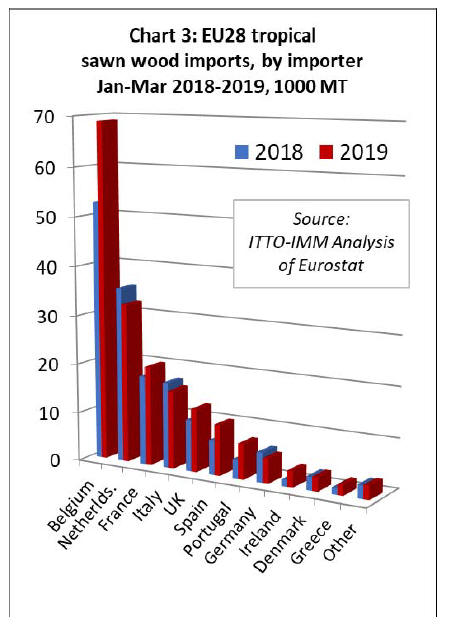
Slowdown in EU imports of tropical logs
After recovering a little ground in 2018, EU imports of
tropical logs slowed again in the first quarter of 2019.
Imports of 23,500 MT during the first quarter of the year
were 10% less than the same period in 2018. Import value
fell 16% to €11.2 million during the period.

While EU imports of tropical logs increased by 20% to
7,680 MT from Congo, the leading supplier, this was
offset by falling imports from the Central African
Republic (-5% to 4,730 MT), DRC (-5% to 4,100 MT) and
Cameroon (-33% to 2,260 MT).
There were also zero EU imports of tropical logs from
Liberia during the first quarter of 2019 compared to 1790
MT in the same period last year. (Chart 4 above).
All three of the leading EU markets for tropical logs
declined in the first quarter of 2019 compared to the same
period last year; imports fell 7% to 11,200 MT in France,
26% to 4,360 MT in Belgium, and 10% to 3,450 MT in
Portugal.
Sharp rise in EU tropical moulding imports
EU imports of tropical mouldings (which includes both
interior mouldings and exterior decking products)
increased sharply, by 30%, to 32,900 MT in the first
quarter of 2019. Import value increased 46% to €54
million.
EU imports of tropical mouldings increased from all the
leading suppliers of this commodity in the first quarter of
2019 including Indonesia (+22% to 19,000 MT), Peru
(+45% to 3,600 MT), Malaysia (+21% to 3,400 MT),
Gabon (+124% to 2,300 MT) and Bolivia (+40% to 1,900
MT) (Chart 5).
In the first quarter of 2019, imports of tropical mouldings
increased in all the leading EU markets including
Germany (+33% to 9,500 MT), Netherlands (+30% to
7,400 MT), France (+58% to 5,100 MT), Belgium (+11%
to 4,600 MT), and the UK (+49% to 3,500 MT).
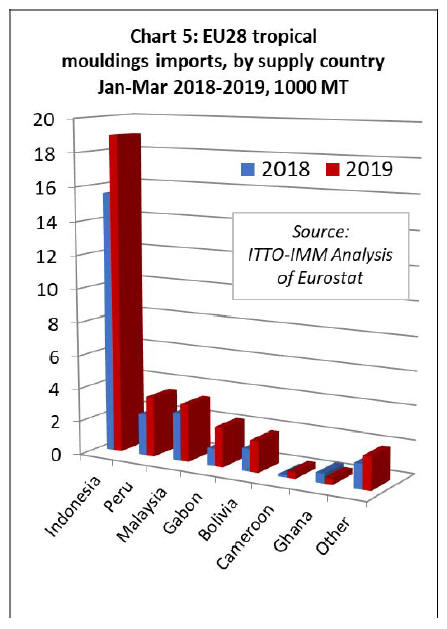
Tropical Asian suppliers make gains in EU joinery
market
EU imports of tropical joinery products, mainly doors
(from Indonesia), and laminated window scantlings and
kitchen tops (from all leading tropical suppliers), increased
21% to 42,300 MT in the first quarter of 2019. Import
value increased 26% to €87.2 million.
EU imports of tropical mouldings increased in the first
quarter of 2019 from all three of the countries that
dominate international trade in tropical joinery products
including Indonesia (+15% to 22,600 MT), Malaysia
(+33% to 13,100 MT), and Viet Nam (+17% to 4,300 MT)
(Chart 6).
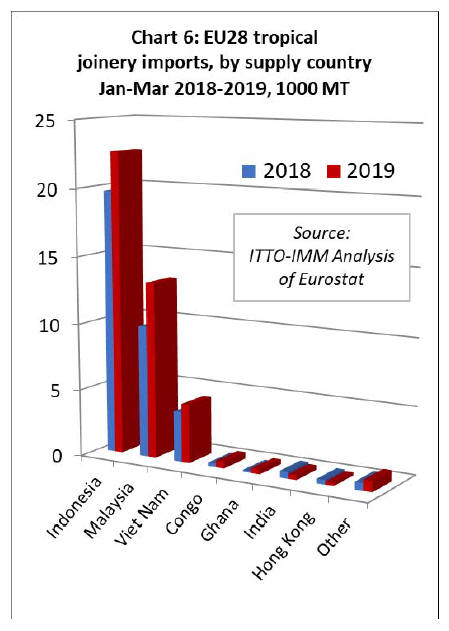
In the first quarter of 2019, imports of tropical joinery
products increased by 13% to 17,400 in the UK and by
115% to 12,300 MT in the Netherlands. These gains offset
a 10% fall in imports in Belgium to 4,200 MT, a 33% fall
in France to 2,500 MT, and a 14% fall in Germany to 2250
MT.
EU imports of tropical plywood made in China
continue to increase
EU imports of tropical plywood products increased 17% to
86,600 MT in the first quarter of 2019 compared to the
same period last year. Import value increased 24% to
€76.6 million.
A large and growing proportion of the plywood faced with
tropical hardwood imported into the EU is manufactured
in China. The EU imported 41,400 MT of this product
from China in the first quarter of 2019, 55% more than
during the same period in 2018.
Imports also increased from Indonesia, by 6% to 24,700
MT, and from Viet Nam, by 60% to 3,100 MT. These
gains offset a 40% fall in imports from Malaysia, to 7,300
MT (Chart 7).
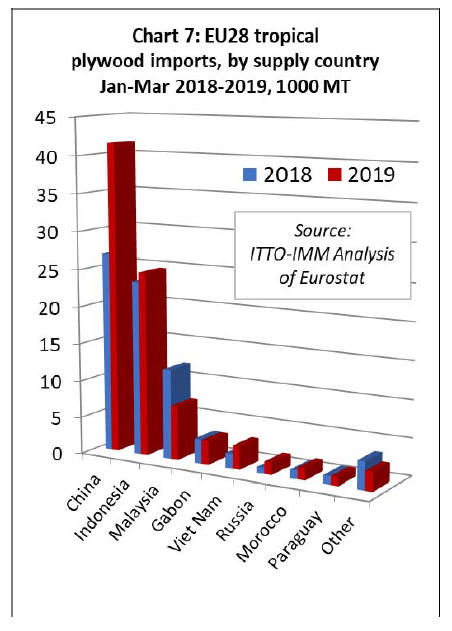
In the first quarter of 2019, imports of tropical plywood
products increased 32% to 47,500 in the UK, by 45% to
8,700 MT in the Netherlands, and by 3% to 6,700 MT in
Germany. These gains offset a 5% fall in imports in
Belgium to 11,000 MT, a 14% fall in France to 4,750 MT,
and a 12% fall in Italy to 4,050 MT. (Chart 8).

EU imports of tropical veneer up 11%
EU imports of tropical veneer increased 11% to 31,800
MT in the first quarter of 2019 compared to the same
period last year. Import value increased 13% to €42.6
million.
The EU imported 12,970 MT of veneer from Gabon in the
first quarter of 2019, 3% more than during the same period
in 2018. Imports from Cameroon rose sharply, by 68% to
4,300 MT, after a poor year in 2018.
There was also a significant increase in imports from two
smaller African suppliers of this commodity, Equatorial
Guinea (+61% to 1000 MT) and DRC (+700% to 900
MT). Meanwhile imports from several long-term veneer
suppliers to the EU lost ground, including Cote d’Ivoire (-
2% to 7,200 MT), Congo (-8% to 2,560 MT), and Ghana
(-6% to 1,050 MT). (Chart 9).
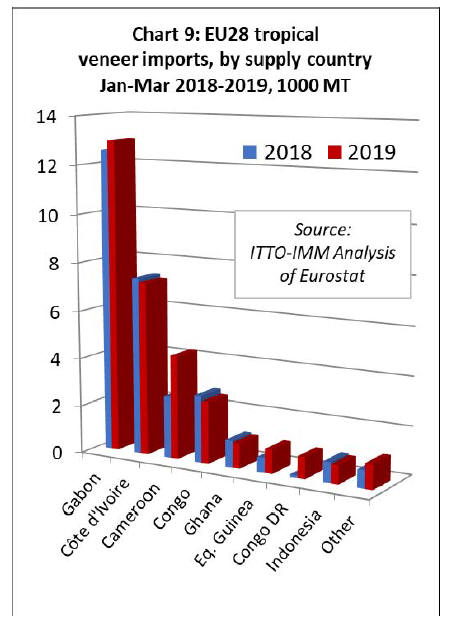
In the first quarter of 2019, tropical veneer imports
increased by 10% in France, to 11,600 MT, by 22% in
Italy, to 8,100 MT, and by 120% in Greece to 2,500 MT.
However, imports fell slightly, by 4%, to 4,550 MT in
Spain.
Benefits to UK merchants of stocking wide range of
hardwoods
The first edition of the UK Timber Trade Federation’s
Merchant News (https://ttf.co.uk/latest/merchant-news/)
includes an article focusing on the challenges and
opportunities in the UK hardwood trade.
The article seeks to answer the question “Are merchants
missing out on business by not making available a
selection of sustainably-grown hardwoods from around the
world”?
The article highlights how the market for hardwoods in the
UK is constrained by the costs to merchants of holding a
diverse range of expensive stock as well as by lack of
knowledge of end-users of the wide range of species
available.
The article quotes John Dowd, Specialised Product
Category Director at International Timber,one of the UK’s
largest hardwood importers: “For many merchants the
main difficulty is not having sufficient space to carry the
ideal inventory: boards may not be the right width or
length for bespoke joinery work, for example.
The main hardwood species we find demand for are
American white oak, sapele, meranti, European oak,
beech, and, for decking, bangkirai. One or two merchants
succeed by keeping a small stock of hardwoods on the
ground in-branch, but sawn hardwood lumber can be
expensive to stock“.
Commenting on the main hardwood species available to
UK buyers and their respective uses, Chris Bowen-Davies,
Key Accounts Manager at Brooks Bros Timber, notes that:
“In terms of African hardwoods, sapele is our largest
seller. It’s a good all-rounder for external and internal use,
with reasonable density and good machining capabilities.
It’s good for paint application too. Utile is still favoured
as it tends to be more stable than many external
hardwoods.
“Iroko is classed as Very Durable and lasts well in outdoor
situations. It can be used for example as cill sections or
for other outdoor joinery. It can also be used in boatbuilding
and garden furniture, as well as for marine work,”
Brooks’ Chris Bowen-Davies says. “idigbo is another
durable material, but it needs a primer coat before any top
paint coat is applied. Its availability from legal and
sustainable sources can be somewhat erratic.
Travelling further round the globe, meranti, which comes
from Se Asia, is a very popular joinery hardwood used in
window and door manufacturing. It paints satisfactorily
but its density can vary considerably.”
The article notes that UK merchants are seeing a sales
benefit from stocking the more familiar types of
hardwood, in defined ranges to suit particular market
segments, as Business Development Director at builders’
merchants MGM Timber, relates: “We stock a range of
hardwood mouldings in our branches.
European oak mouldings match the current fashion for
Oak flooring, joinery and kitchens. We also stock meranti
mouldings for the replacement market, including skirtings,
architraves and window cill sections.
“The market for hardwood mouldings is very wideranging,
from the enthusiastic DIYer to builders and
joiners involved in RMI, window fitters and even
housebuilders.
Local housebuilders want to increase the value of the
homes they build by providing a high quality finish, which
is where hardwood mouldings come in,” Grant Wilson
says.
Grant Wilson also notes that “ensuring sustainable
sourcing is of primary importance on hardwoods”, and this
is a theme also highlighted by TTF Managing Director
David Hopkins. Hopkins particularly emphasises the role
of the FLEGT VPA process which is seen as having strong
market development potential in the UK.
According to Hopkins, “FLEGT licensing is a mechanism
for ensuring the legality of harvesting and supply at
country-level, whereas the two main certification schemes
license at individual forest and producer level.
Merchants should watch the FLEGT space as a number of
African countries are going through the licensing process,
which will eventually make more species available for
purchase under EUTR rules.”
|